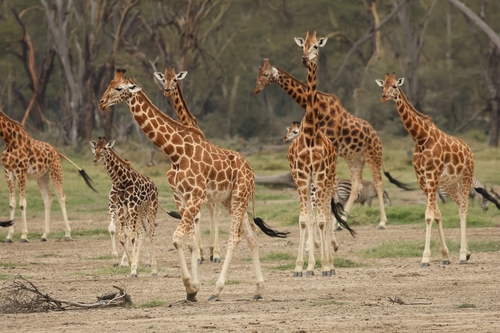
Giraffe
With their towering necks and patchwork coats, Giraffa camelopardalis stands as the world's tallest mammal. These gentle giants, native to African savannas, gracefully browse treetops, crucially dispersing seeds and fostering biodiversity. Their striking appearance and serene behavior make giraffes an iconic symbol of the wild.
20-25 years
Lifespan
550.0 kg
Weight
Height: 45388.0 m
Size
Brown, Red, Black, White, Tan
Color
3.5-4.5 years
Age of Sexual Maturity
13 months
Age of Weaning
30 mph
Top Speed
Vulnerable
Conservation Status
Decreasing
Population Trend
Characteristics
Giraffes are the tallest terrestrial animals, with long necks and legs, distinctive coat patterns, and small, horn-like ossicones. They inhabit African savannas and woodlands, feed primarily on acacia leaves, and are known for their gentle browsing behavior. Giraffes play a crucial role in seed dispersal and maintaining plant biodiversity.
Distribution Range of the Giraffe
Giraffa camelopardalis, commonly known as the giraffe, is native to sub-Saharan Africa. Its geographical distribution includes countries such as Kenya, Tanzania, Botswana, Namibia, South Africa, and Zimbabwe. The range extends across the savannahs, grasslands, and open woodlands of these regions.
Giraffe's Habitat
Environmental Conditions
The typical habitat of giraffes includes savannahs, grasslands, and open woodlands. These environments are characterized by a tropical or subtropical climate with distinct wet and dry seasons. The vegetation is primarily composed of acacia trees and other browsing flora that provide food for giraffes.
Ecological Niche
Giraffes play a crucial role in their ecosystem by browsing on tall trees and shrubs, which helps control the growth of vegetation and maintain the structure of the savannah. Their long necks allow them to reach foliage inaccessible to other herbivores, reducing competition for food resources. Giraffes are also important prey for large predators like lions.
Copyright @ Nature Style Limited. All Rights Reserved.
 English
English